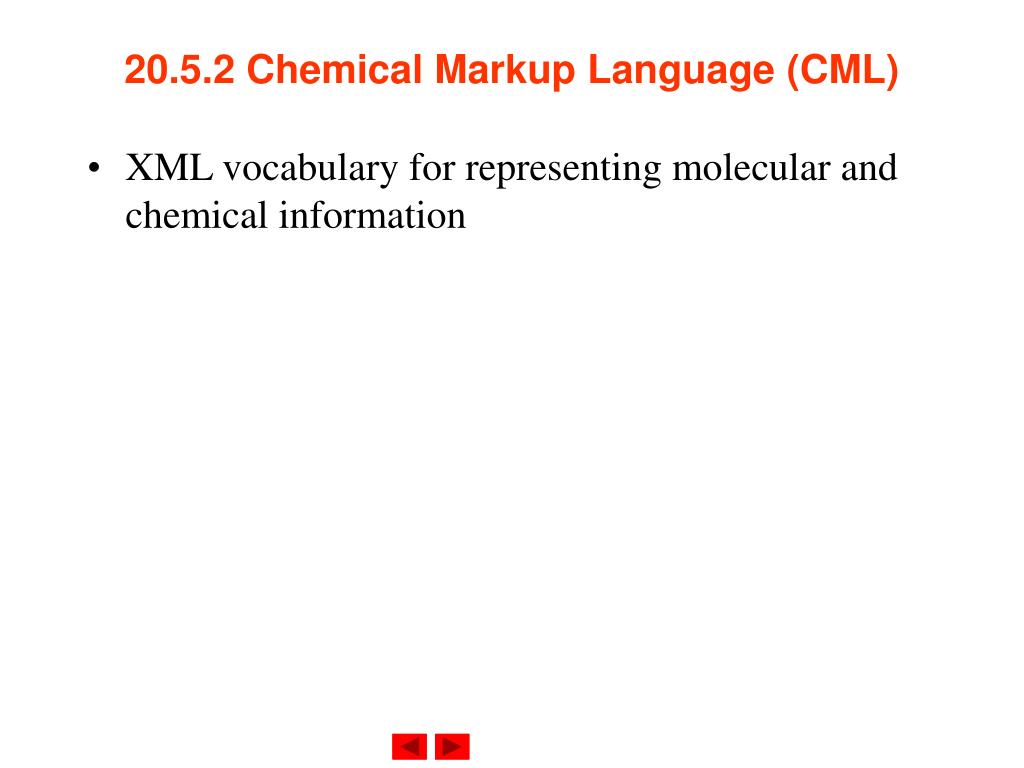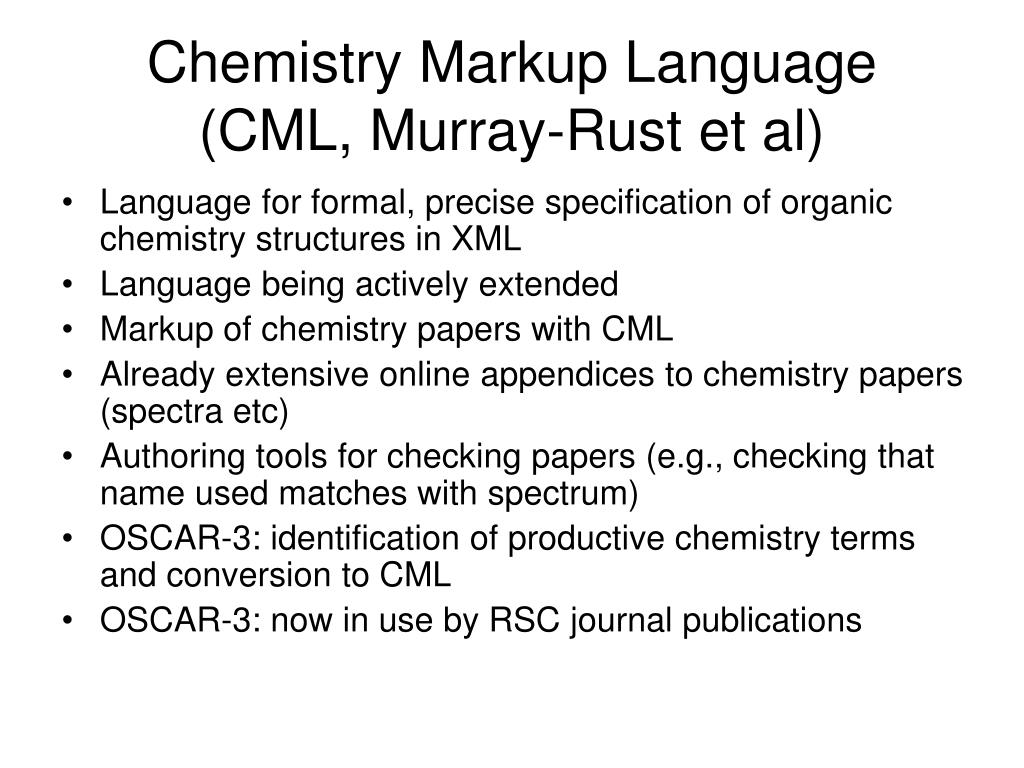Chemical markup language (CML) is a powerful tool for representing and exchanging chemical data. It provides a standardized format for describing chemical structures, reactions, and properties, making it easier to share and collaborate on chemical information. In this guide, we will explore the key features of CML, its applications, and the tools and resources available for working with it.
CML has a rich history, dating back to the early days of computer-aided chemistry. Over the years, it has evolved to meet the changing needs of the chemical community. Today, CML is widely used in a variety of applications, including cheminformatics, drug discovery, and materials science.
Overview of Chemical Markup Language

Chemical Markup Language (CML) is a powerful tool for representing chemical information in a structured and machine-readable format. It is based on XML and provides a standardized way to encode chemical structures, reactions, and other chemical data.
CML was developed in the early 2000s by a consortium of chemists and computer scientists. The first version of CML was released in 2004, and the language has been under continuous development ever since.
Applications of CML
- CML is used in a wide variety of applications, including:
- Storing and managing chemical data
- Exchanging chemical information between different software systems
- Visualizing chemical structures and reactions
- Teaching and learning chemistry
Key Features of CML
Chemical Markup Language (CML) is an XML-based language specifically designed for representing and exchanging chemical data. It offers a comprehensive set of features that enhance the accuracy, consistency, and interoperability of chemical information.
The key features of CML include:
- Extensibility:CML is an extensible language that allows users to define their own tags and attributes to represent specialized chemical data.
- Flexibility:CML can be used to represent a wide range of chemical data, including molecules, reactions, spectra, and experimental data.
- Accuracy:CML uses a rigorous XML schema to ensure the accuracy and validity of chemical data.
- Consistency:CML provides a consistent framework for representing chemical data, reducing the risk of errors and misunderstandings.
- Interoperability:CML is an open standard that is supported by a wide range of software applications, enabling the seamless exchange of chemical data between different systems.
Data Representation in CML
CML documents are structured hierarchically, with the root element being
Chemical entities, such as molecules, atoms, and bonds, are represented using specific CML tags. For instance, the
Attributes and Elements in CML
Attributes and elements play crucial roles in CML. Attributes provide additional information about chemical entities, while elements define the structure and organization of the CML document.
- Attributes:Attributes are name-value pairs that provide specific information about chemical entities. For example, the
tag can have attributes such as “id” to uniquely identify an atom, “elementType” to specify the chemical element, and “x” and “y” to define its position in space. - Elements:Elements are the building blocks of CML documents and represent different chemical concepts. They can be nested to create complex chemical structures. For instance, a
element can contain multiple elements and elements to define a molecular structure.
Data Exchange with CML

CML plays a pivotal role in facilitating the exchange of chemical data between diverse software applications. Its standardized format enables seamless data transfer, fostering interoperability and collaboration within the scientific community.
Role of CML in Data Interoperability
CML serves as a common language for representing chemical data, allowing different software applications to interpret and process information consistently. This interoperability eliminates the need for manual data conversion or complex data integration processes, streamlining workflows and enhancing data accessibility.
Examples of CML’s Use in Data Exchange Scenarios, Chemical markup language
- Database Integration:CML facilitates the integration of chemical data from multiple databases, enabling comprehensive analysis and data mining.
- Scientific Collaboration:CML allows researchers to share chemical data seamlessly, fostering collaboration and enabling the exchange of complex molecular structures and properties.
li> Data Archiving:CML provides a standardized format for archiving chemical data, ensuring its long-term preservation and accessibility for future research.
Tools and Resources for CML

Working with CML requires the use of appropriate software tools, libraries, parsers, and validators. These resources aid in the creation, manipulation, and validation of CML documents, facilitating the effective exchange and utilization of chemical data.
Software Tools for CML
- Open Babel: A versatile chemistry toolkit that supports CML import and export, enabling the conversion of CML files to various other chemical formats.
- RDKit: A cheminformatics library that provides CML parsing and writing capabilities, allowing for the manipulation and analysis of chemical structures represented in CML.
- ChemDraw: A commercial chemical drawing software that offers CML import and export functionality, enabling the seamless integration of CML data with other chemical applications.
CML Libraries, Parsers, and Validators
In addition to software tools, there are specialized libraries, parsers, and validators available for working with CML.
- CMLDOM: A Java library for parsing and manipulating CML documents, providing an object-oriented interface for accessing and modifying CML data.
- Libcml: A C library for parsing and validating CML documents, offering high-performance CML processing capabilities.
- CML Validator: An online tool for validating CML documents against the CML schema, ensuring the structural correctness and adherence to CML standards.
Online Resources and Communities for CML Users
Several online resources and communities provide support and collaboration opportunities for CML users.
- CML Wiki: A comprehensive resource containing documentation, tutorials, and examples related to CML, serving as a valuable knowledge base for users.
- CML Google Group: An active online discussion forum where users can ask questions, share experiences, and collaborate on CML-related topics.
- CML GitHub Repository: A repository hosting the official CML specification, reference implementations, and other related resources, providing a central hub for CML development and community contributions.
Applications of CML: Chemical Markup Language
CML has gained widespread adoption in various fields, offering numerous benefits and facilitating diverse applications. Its versatility and flexibility make it suitable for a range of tasks, including data exchange, visualization, and computational chemistry.
Case Studies and Examples
CML has been successfully employed in numerous case studies and real-world applications, demonstrating its practical utility and impact across disciplines.
- Drug Discovery:CML enables efficient representation and exchange of chemical structures, facilitating collaboration and data sharing among researchers in the pharmaceutical industry.
- Materials Science:CML provides a standardized framework for representing and analyzing complex chemical structures, aiding in the design and development of new materials.
- Bioinformatics:CML plays a crucial role in bioinformatics, facilitating the storage, retrieval, and analysis of chemical data related to biological systems.
Benefits and Limitations
While CML offers significant advantages, it also has certain limitations that should be considered when selecting it for specific applications.
- Benefits:
- Standardized and extensible data representation
- Facilitates data exchange and collaboration
- Supports visualization and computational chemistry
- Limitations:
- May not be suitable for all types of chemical data
- Requires specialized tools and expertise for implementation
- Can be complex to learn and use effectively
Potential Future Applications
CML continues to evolve and expand its applications, with promising potential for future advancements.
- Artificial Intelligence (AI):CML can serve as a foundation for AI-powered chemical discovery and materials design.
- Quantum Computing:CML can be adapted to represent and process chemical data on quantum computers, enabling new possibilities for computational chemistry.
- Personalized Medicine:CML can facilitate the development of personalized drug therapies based on individual genetic profiles.
Final Wrap-Up
CML is a versatile and powerful tool that can be used to represent and exchange chemical data in a variety of applications. Its standardized format makes it easy to share and collaborate on chemical information, and its rich feature set provides the flexibility to represent even the most complex chemical structures and reactions.
As the chemical community continues to grow and evolve, CML will undoubtedly continue to play an important role in the exchange and dissemination of chemical knowledge.
FAQ Corner
What is CML?
CML is a standardized format for representing and exchanging chemical data. It provides a way to describe chemical structures, reactions, and properties in a way that can be easily understood by both humans and computers.
What are the benefits of using CML?
CML offers a number of benefits, including:
- Improved data sharing and collaboration
- Increased data accuracy and consistency
- Reduced time and effort required to manage chemical data
What are the applications of CML?
CML is used in a variety of applications, including:
- Cheminformatics
- Drug discovery
- Materials science
- Education